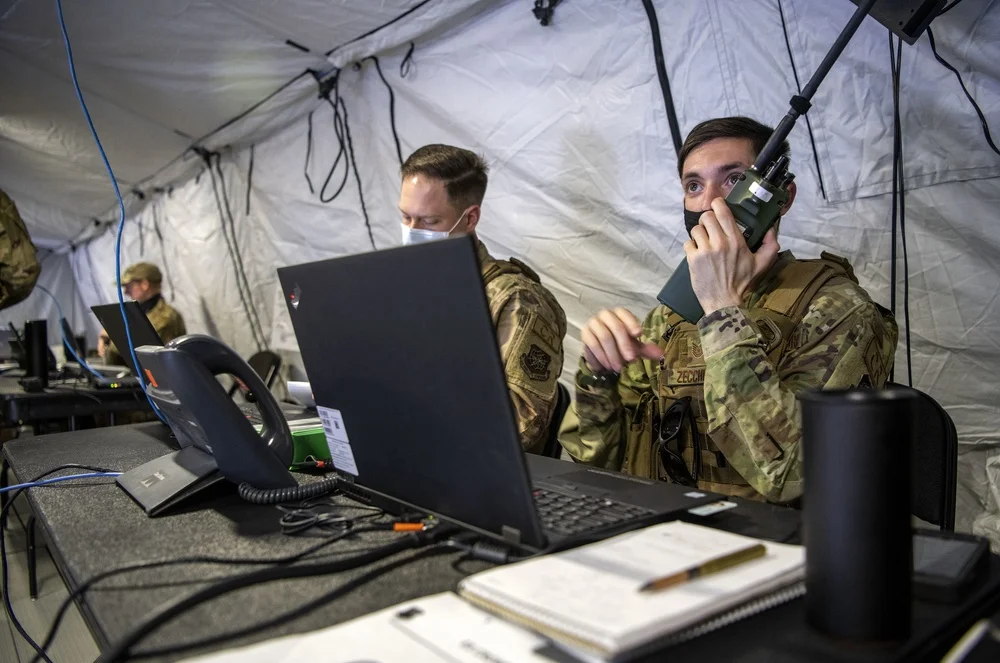DVIDS – News – 821 CRG’s alert force prepped for contingencies, worldwide deployment
Earthquakes. Hurricanes. Pandemics. Air base openings. Remote airfields.
“This is what we prepare for,” said Capt. Sean Dronen, 921st Contingency Response Squadron assistant operations officer.
More than 100 Airmen from the 821st Contingency Response Group at Travis Air Force Base, California, assumed the responsibility to be anywhere in the world in 12 hours as of June 1.
Assuming “alert” for the 621st Contingency Response Wing means members of the 921st CRS and the 821st Contingency Response Support Squadron fulfill the needs of their higher headquarters of Air Mobility Command and U.S. Transportation Command.
Normally, squadrons spend the months and weeks prior to assuming alert as their opportunity to perform last-minute checks to ensure all Airmen have the necessary training and proficiencies needed to meet AMC’s unit type code or UTC taskings.
“Unfortunately, COVID had other plans,” said Maj. Ramiro Rios, 921st CRS operations officer. “But it’s given our Airmen the opportunity to be creative and find innovative ways to conduct training and still get the job done.”
Since mid-March, many of the 621st CRW Airmen have switched to teleworking to adhere to the Center for Disease Control and Prevention guidelines of physical distancing. Despite restrictions due to the coronavirus, the 921st CRS and 821st CRSS were still able to prepare.
“We’re able to maintain readiness by continuing to support some GAMSS [Global Air Mobility Support System] taskings, our maintenance and aerial port Airmen embedded with the 60th [Air Mobility Wing] and flight leaders provided scenario-based ‘homework’ to their members to brush up on skills,” said Dronen, the Contingency Response Element assistant director of operations for the alert force. “We still conducted in-person training, such as tactical operations center exercises, but we ensured safe practices of physical distancing, face coverings and we reiterated good personal hygiene.”
This type of training is required before the alert cycle, but this time was even more valuable.
“As any other military organization, we lose continuity and experience when Airmen PCS (permanent change of station) and we are no exception,” said Rios. “Some of our alert force have never been on alert before, but this experience will be invaluable as new CR Airmen arrive.”
Real-world contingency experience may come sooner than many would think as the National Oceanic and Atmospheric Administration predicts 2020’s Atlantic hurricane season to be “above normal.” According to the NOAA’s Climate Prediction Center, the administration forecasts 13-19 named storms from June to December, with as many as six storms being major hurricanes of category 3 or higher.
“It’s no secret that this alert time frame is historically busy and we are no strangers to hurricane support,” said Dronen.
In previous years, the CRW has provided support for hurricanes Rita, Ike, Sandy and Michael. But the CRW has supported more than hurricanes during this block; this time last year, the alert force from the 621st Contingency Response Group at Joint Base McGuire-Dix-Lakehurst, New Jersey, supported the re-opening of Prince Sultan Air Base, Saudi Arabia to establish air base operations as part of U.S. Central Command’s commitment to providing stability and security in the region.
“The key is: we have to be ready for anything,” said Lt. Col. Robert Kline, 921st CRS commander. “We never know when that call will come in or what we’ll be supporting, but we’re ready and eager to answer that call.”
| Date Taken: | 06.08.2020 |
| Date Posted: | 06.08.2020 15:05 |
| Story ID: | 371689 |
| Location: | TRAVIS AIR FORCE BASE, CA, US |
| Web Views: | 327 |
| Downloads: | 0 |
PUBLIC DOMAIN
This work, 821 CRG’s alert force prepped for contingencies, worldwide deployment, by MSgt David W. Carbajal, identified by DVIDS, must comply with the restrictions shown on https://www.dvidshub.net/about/copyright.


 Private Internet Access gives you unparalleled access to thousands
of next-gen servers in over 83 countries and each US state. Your
VPN experience will always be fast, smooth, and reliable.
Private Internet Access gives you unparalleled access to thousands
of next-gen servers in over 83 countries and each US state. Your
VPN experience will always be fast, smooth, and reliable.

